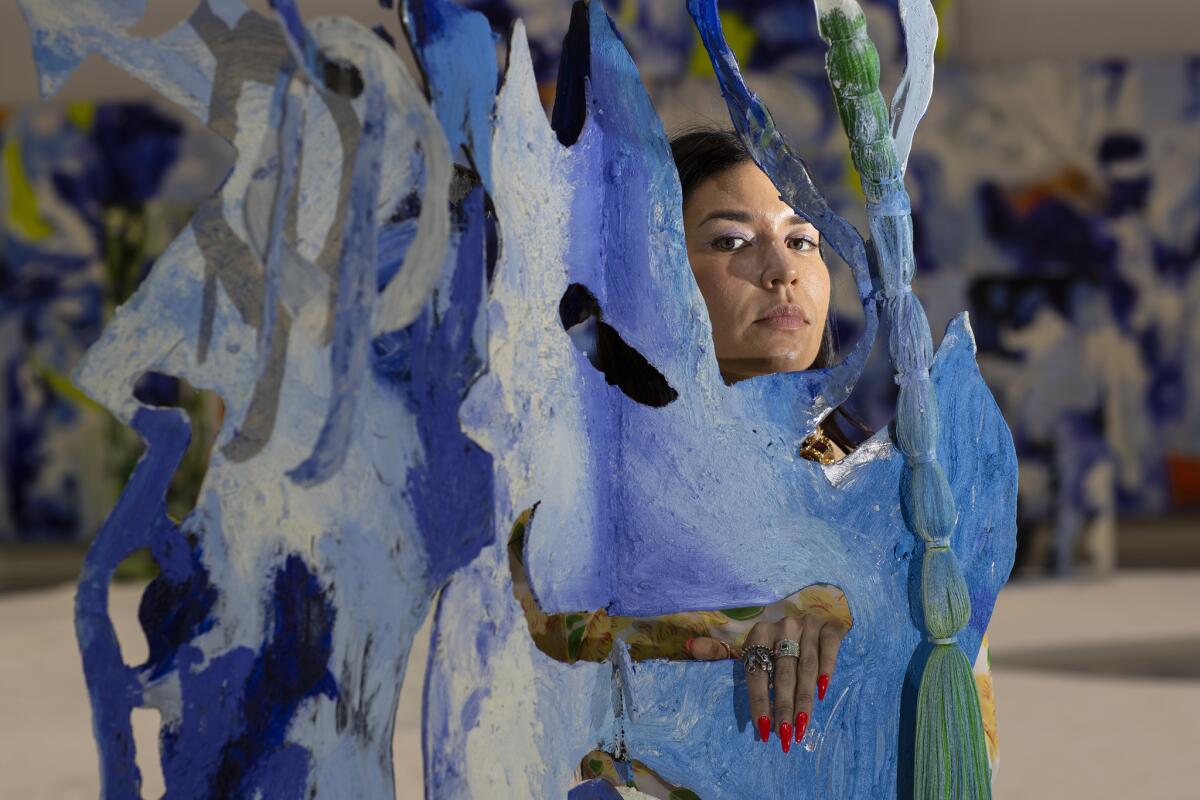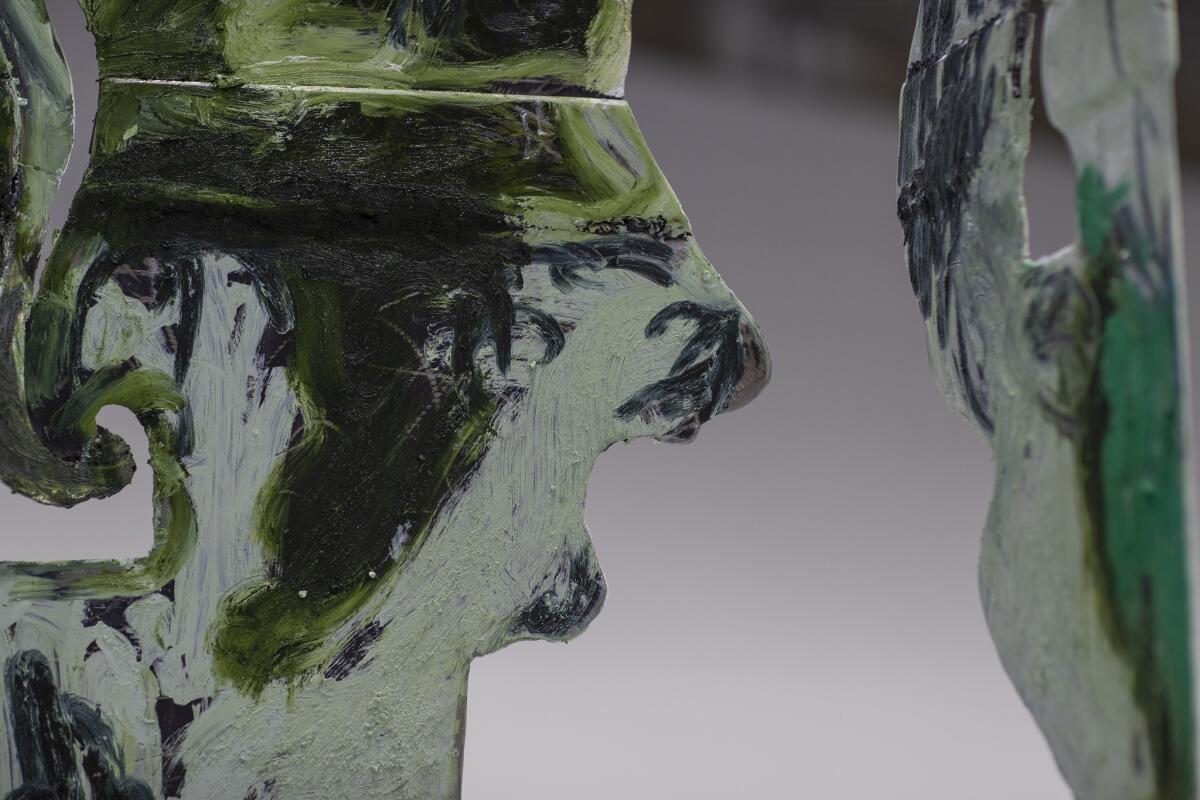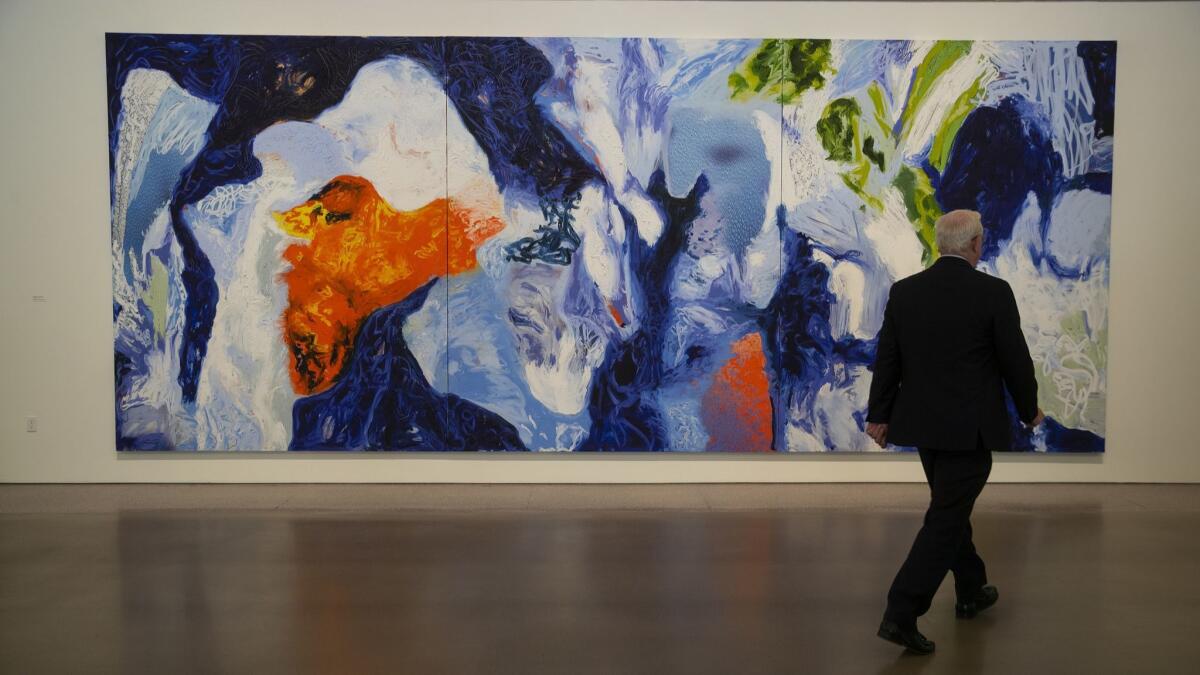With semi-nude models, Donna Huanca brings femme power into a male art world

- Share via
Donna Huanca says her deep and enduring artistic interest in the female body stems from a simple fact: She has one.
She also says she’s tired of seeing female bodies brutalized, tired of viewing them via the male gaze.
“In art history, women have been depicted in such a vulnerable way. This is a new way of looking at the feminine form, and in that gesture I’m trying to distort the male gaze, to have it be so powerful that it reflects back in a different way.”
Huanca is standing in a sea of her art, surrounded by deep ocean blues and pops of rusty orange and chartreuse oil paint against a stark white backdrop. She’s inside the Marciano Art Foundation’s 13,000-square-foot Theater Gallery a few days before the opening of her show “Obsidian Ladder,” which runs from Friday to Dec. 1.
Huanca’s parents are Bolivian; she was born in Chicago and raised in Houston. Today she lives in Berlin — a great place to “hide and make work and have a studio,” she says. This is her first major museum show in the U.S.
With her long, flowing black hair, silk emerald-green blouse and jeans covered in graphic paint, Huanca almost looks like a piece of her own artwork, as if she were one of the colorfully painted live models who will populate the space each Saturday during the run of the show.
Huanca’s stylized, semi-nude models are just one element in an immersive ecosystem that also includes layered, vibrant abstract paintings, colorful figurative steel sculptures, looping audio and a specially designed scent diffused throughout the room.
In Huanca’s hands, the Marciano gallery has been dramatically transformed. A pungent smell (more on that later) and the occasional low rumble of a pussycat’s amplified purr or the gentle indigenous-language chanting of the artist’s grandmother fill the atmosphere. The installation’s sloping white walls obscure the hall’s towering concrete ones, creating a wide V shape that draws the eye toward a curvy island of white, crushed quartz and marble sand inhabited by sculptures and quietly meditating models.

With the goal of creating a highly femme space, the artist says she first had to grapple with the architecture of the room.
The Marciano Art Foundation is housed in a former Scottish Rite Masonic Temple on Wilshire Boulevard. Designed in 1961 by Millard Sheets, the imposing structure was created by men, for men. Even after its modern adaptation into a museum (also by a male architect), the building’s Theater Gallery has — until now — served as a vessel only for installations by male artists (Jim Shaw, Olafur Eliasson and Ai Wei Wei).
“This architecture wants to dominate you, and it feels very patriarchal,” Huanca says. “Working in this room, it felt like I was wrestling a giant. We’re surrounded by all these secret codes of power. I wanted to uproot that and reverse it, and that’s what I hope we did. This [artwork] has its own codes, its own language too.”
That language — Huanca’s language — is an intuitive, inwardly focused and inherently feminine one.
In her practice, for instance, the way models are treated, protected and cared for during the run of the show is as important as how they look and move in front of visitors.
“I don’t like to follow rules, so I’m OK with them veering off course,” Huanca says, explaining the loose nature of the show’s choreography. “I really rely on the relationships with my models to create this environment. We trust each other. There’s so much conversation that goes into things like security and creating a safe and comfortable space for the models. We are sort of reconfiguring what is the norm of having an art show. When there are live people in your space, you have to take care of them and be flexible to the different conditions that might arise.”
Nine models who identify as female will perform throughout the run of the show: two longtime Huanca collaborators and seven local to Los Angeles. To keep them warm, heaters have been placed beneath the white sandbar on which they walk and pose. In place of itchy makeup, organic materials such as clay and egg whites are used to sculpt their bodies and hair.
Stationery is provided backstage, and they are encouraged to journal after each performance. (Huanca keeps the journals for documentation and for potential future publication.) The vibe is spa-like, Huanca says, because although the models are being paid to do this work, the experience should feel less transactional and more healing, peaceful and meditative.
Covered in body paint and outfitted with exaggerated hair extensions and custom-molded, transparent vinyl “armor,” the models look like elegant exotic birds nesting on an art-filled tropical island. Much like birds, they do their own thing. Huanca describes them as powerful and peaceful warriors. Unaffected by crowds and visitors, they are intent on the task at hand, their focus calm, direct, inward.
Like bird-watching, the experience of viewing these models feels somewhat voyeuristic, as if you are observing an otherworldly creature quietly perform a sacred ritual.
Even in the models’ absence — they appear only one of the four days a week the museum is open — the impressions of their bodies remain. Their footprints are visible in the sand, and colorful debris from their “costumes” peppers the sculpture island. They’ve also rubbed their blue-painted bodies against the gallery’s back wall, leaving a soft, messy smudge that will forever be a part of the Marciano’s DNA. The blue eventually will be painted over but never washed off.


Subtle remnants of women’s bodies are embedded in Huanca’s paintings too. Her canvases feature enlarged, close-up photos of models’ painted bodies, which she covers in oil paint mixed with tumeric, sand and coffee grounds. Peeking out from behind the paint are bits of knees and elbows, cobalt blue goose bumps, wavy strands of hair and a repetitive grid of magnified skin.
There’s also body odor.
“Like dank, but friendly dank,” the artist says of the earthy sent she designed with olfactory artist Klara Ravat at Smell Lab in Berlin. “It started with me just burning palo santo in spaces, and then later I started to develop something more rich, something that can’t be described. I want it to be welcoming but also a little bit off-putting.”
The scent can be purchased as part of a shrink-wrapped clay sculpture on sale for $50 in the museum’s bookstore. (A rolling applicator is embedded in the clay.) Huanca says 100% of the proceeds from the scent sculpture and other show-specific pieces go to the Trans Wellness Center in Koreatown, the East Los Angeles Women’s Center and Reach L.A., which serves young LGBTQ people of color.
Huanca says if you purchase the object, you can keep it as a sculpture or remove the scent and use it. But, she warns with a smile, it packs a powerful punch.
After all, it is a scent designed for a big job: cleansing a 13,000-square-foot space dominated by men for decades so that femme art and bodies can thrive.
=====
Donna Huanca’s ‘Obsidian Ladder’
Where: Marciano Art Foundation, 4357 Wilshire Blvd., L.A.
When: Thursdays-Sundays, through Dec. 1
Admission: Free; timed-entry reservations strongly recommended
Info: (424) 204-7555, marcianoartfoundation.org

Support our coverage of the local arts scene by becoming a digital subscriber and reading our latest news and reviews at latimes.com/arts.
More to Read
The biggest entertainment stories
Get our big stories about Hollywood, film, television, music, arts, culture and more right in your inbox as soon as they publish.
You may occasionally receive promotional content from the Los Angeles Times.










